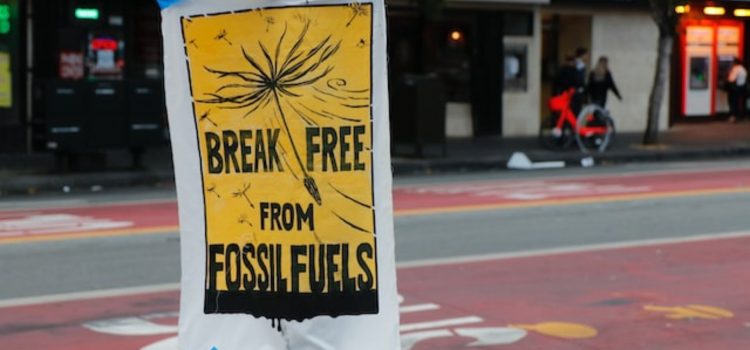

This article is an excerpt from the Shortform book guide to "Apocalypse Never" by Michael Shellenberger. Shortform has the world's best summaries and analyses of books you should be reading.
Like this article? Sign up for a free trial here.
How can we move toward fuel sources with higher energy density and power density? What difference does that make for the environment, the economy, and society as a whole?
The primary driver of climate change, and the most important issue to tackle, is society’s ever-growing energy consumption. In Apocalypse Never, Michael Shellenberger explains the problem and explores our options as we move into the future.
Continue reading to learn about climate change and energy consumption.
Climate Change & Energy Consumption
The trend throughout the history of civilization has been moving from weak, diffuse sources of fuel to more compact and powerful methods of energy use and generation. To help us understand the connection between climate change and energy consumption, Shellenberger explains the concepts of energy density and power density. He also details the progression toward energy-dense fuels and how politics and emotion can get in the way of necessary and beneficial progress.
(Shortform note: Another important metric to consider in addition to energy and power density is the carbon footprint—the amount of greenhouse gas (primarily carbon dioxide and methane) released into the atmosphere by an energy source, organization, product, or person. There are several calculators available online that allow you to estimate your own carbon footprint.)
Energy density is the measure of how much energy is stored per volume in any given fuel source. For instance, a sugary snack is more energy-dense than a head of lettuce. Likewise, a lump of coal is more energy-dense than a burning log. The opposite of energy-dense fuels are those that are energy-diffuse, which store less energy per volume and require greater effort to extract. For example, the first fuel the human race used was wood, which takes time and effort to cut down and burn, decimating forests and polluting the air. Coal, while still a pollutant, is more energy-dense than wood—it produces more energy from far less land than cutting down trees for the same amount of power.
(Shortform note: While coal has been used as a power source for thousands of years, it came to prominence during the Industrial Revolution, when it was used for smelting iron and powering mechanical equipment. Even then, pollution from coal had a negative impact on public health, later culminating in the Great London Smog of 1952 that resulted in thousands of deaths over a five-day period. Today, coal remains the largest single source of carbon emissions, accounting for a third of the world’s total production of electricity.)
From coal, the next steps on the energy density ladder are petroleum, natural gas, and nuclear power. In addition to providing more power than the next, each step toward higher energy density releases less pollution into the environment per unit of energy than the one before. Nevertheless, Shellenberger points out that we’re burning more trees today than ever before, due to population growth and the fact that people in many poor countries have no other fuel source than wood. Therefore, transitioning developing countries to energy-dense fuel sources should be a top priority for environmentalists, if only to stop deforestation.
| Driving Cars Toward Energy Density Energy density also matters when it comes to energy storage, a field in which the automotive industry has recently been a leading innovator. With the ongoing shift toward electric vehicles, car manufacturers have been developing energy-dense batteries for cars. As a result, the amount of energy that lithium battery packs can hold has increased eightfold in only 12 years. In addition to releasing no tailpipe emissions, electric vehicles are more energy efficient than gas-powered cars, but that energy still has to come from somewhere. Power companies are preparing the grid for the added strain of electric vehicle fleets, in the face of pushback from the oil and gas industry. However, despite claims to the contrary, electric vehicles have a smaller carbon footprint than those powered by gas, even when emissions from auto manufacturing and power generation are taken into account. |
Along with the trend toward energy density is that toward power density, the amount of energy used or produced per volume. This shift happens as people and industry cluster into smaller spaces. Cities are more power-dense than rural areas, factories are more power-dense than workshops, and industrial farms are more power-dense than old-style agrarian ranges. Similarly, in terms of power output, a gas generator is more power-dense than a wood-burning stove, just as a chemical battery is more power-dense than a generator run by a hamster in a wheel.
Shellenberger says the advantage of this concentration is that it reduces per-person energy consumption. It’s more efficient to power a downtown apartment building for people who can walk to work than it is to provide electricity to houses for the same number of people who live in suburbs and burn gas to commute. The march toward more efficient, less polluting energy would do wonders for the environment and human well-being.
(Shortform note: From an engineering standpoint, power density is crucial for creating efficiency and reducing systemic costs, whether that system is a city or a gadget. At present, the US’s energy infrastructure is dominated by power-diffuse energy sources, such as more than 50 million acres taken up by biofuel production. As the world’s population and energy needs continue to grow, switching to more power-dense systems of energy production and utilization will be necessitated by economies of scale.)
The Problem With Renewables
While wind and solar energy may seem like environmentally harmless sources of limitless power, that isn’t actually the case. Both are energy-diffuse and unreliable, leading to serious practical limitations that minimize their ability to replace other power sources and that impact the environment in their own harmful ways. Shellenberger lists the problematic deficiencies and negative ecological consequences of both solar and wind as sources of power, and he discusses their hidden economic costs, of which most people aren’t aware.
The first problem with solar power is its unreliability. Generating energy for the darkest times of the year would require even more solar farms to be built, which leads to the second problem—land use. Shellenberger says that for the US to meet its current electricity needs with solar farms would require more land than some Atlantic states, land that would be taken away from farming or natural habitats. The third problem with solar power is waste disposal, just as with any other power plant.
The problems with wind power are similar to solar’s. Although the wind blows day and night, all year round, it isn’t consistent and it’s highly unpredictable. Also as with solar, wind farms require a lot of land. Wind turbines also present a danger to wildlife.
The final argument against wind and solar power is the issue of power storage, which is both a logistical and an economic problem. Large-scale power storage is both prohibitively expensive as well as a logistical nightmare. Shellenberger suggests that, as much as wind and solar power meet the romantic ideal of “natural energy,” they simply don’t meet the energy needs of present-day or future generations.
The Case for Nuclear Power
What’s needed instead is a clean, energy-dense alternative. The answer is nuclear power, which is reliable, productive, and has a minimal impact on the environment.
Nuclear power is the most energy-dense fuel source we have available—the amount of nuclear fuel required to generate power is infinitesimal next to the amount of fossil fuels burned by coal and natural gas plants. It’s reliable and affordable enough to provide for the world’s rising energy needs.
Unlike the byproducts of other power sources, nuclear waste is not released back into the environment. The most realistic cause of nuclear material being released into the wild is in the case of a reactor meltdown, of which there have been three, but the impact of those accidents is widely overstated. Shellenberger points out that other energy-related disasters have been far more devastating.
Exercise: How Can You Address Your Climate Impact?
Shellenberger argues that, in order to effectively reduce our impact on the environment, society needs to transition to more energy-dense fuel sources, and that this requires a shift in attitude and awareness about the energy and resources we use. Many individuals are already taking measures to reduce their personal carbon footprint. Take a few moments to think about how your own lifestyle has an impact on the environment.
- Suppose your power company announces a project to build a nuclear power plant within an hour’s drive of your home. Would you be for or against such a project? Would you prefer the implementation of renewable power generation in your area, knowing its costs and limitations? Why or why not?
- Are there specific areas of your life that may leave an outsized carbon footprint, such as a long, fuel-intensive commute, or a poorly insulated home with high heating and cooling costs? Are there changes you would be willing to make in order to offset your carbon contributions?
- Are there lifestyle choices you’ve already made to reduce your carbon footprint? If so, what are they? Are there changes you wish society would enact in order to reduce greenhouse gas emissions, or do you believe it should be left to individuals to decide what personal changes to make?

———End of Preview———
Like what you just read? Read the rest of the world's best book summary and analysis of Michael Shellenberger's "Apocalypse Never" at Shortform.
Here's what you'll find in our full Apocalypse Never summary:
- An assessment of the climate crisis from a rational perspective
- How climate change alarmists are doing more harm than good
- The problems with renewable energy and why we should switch to nuclear






